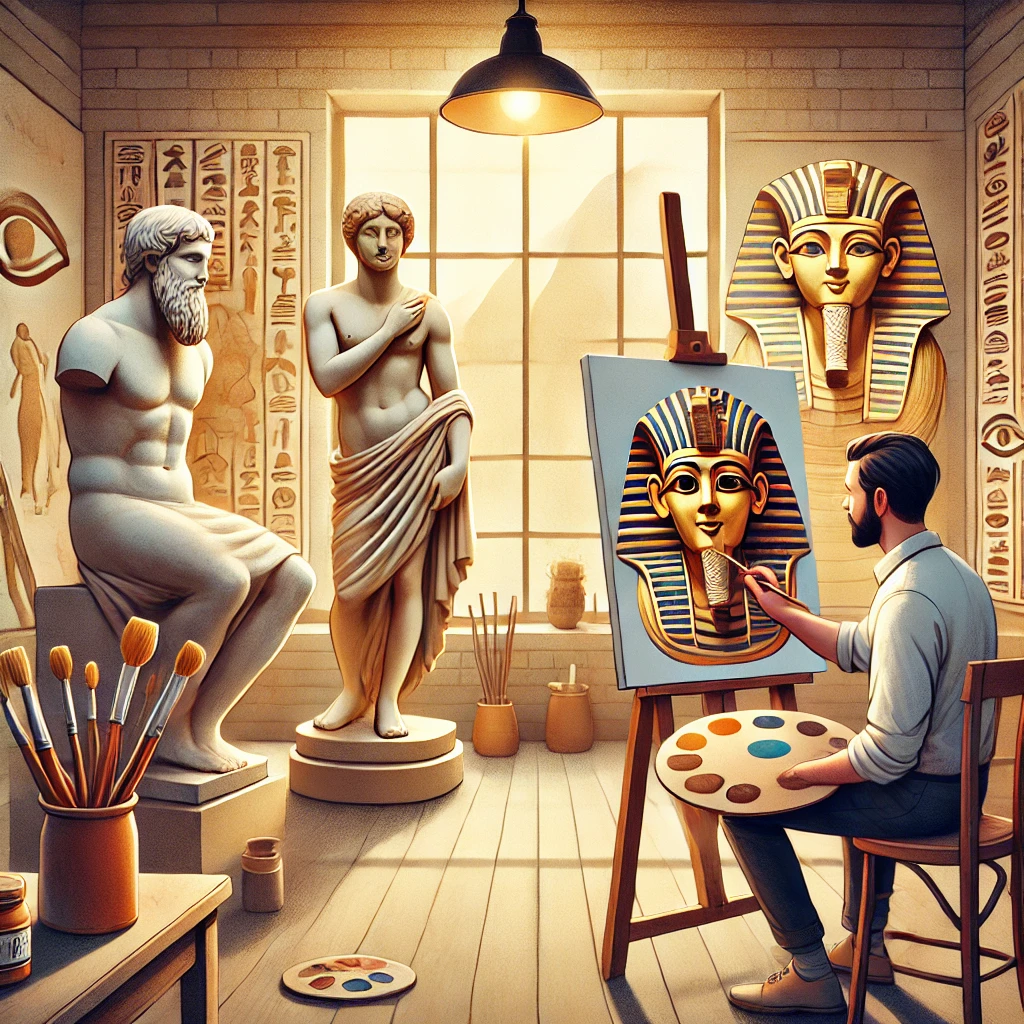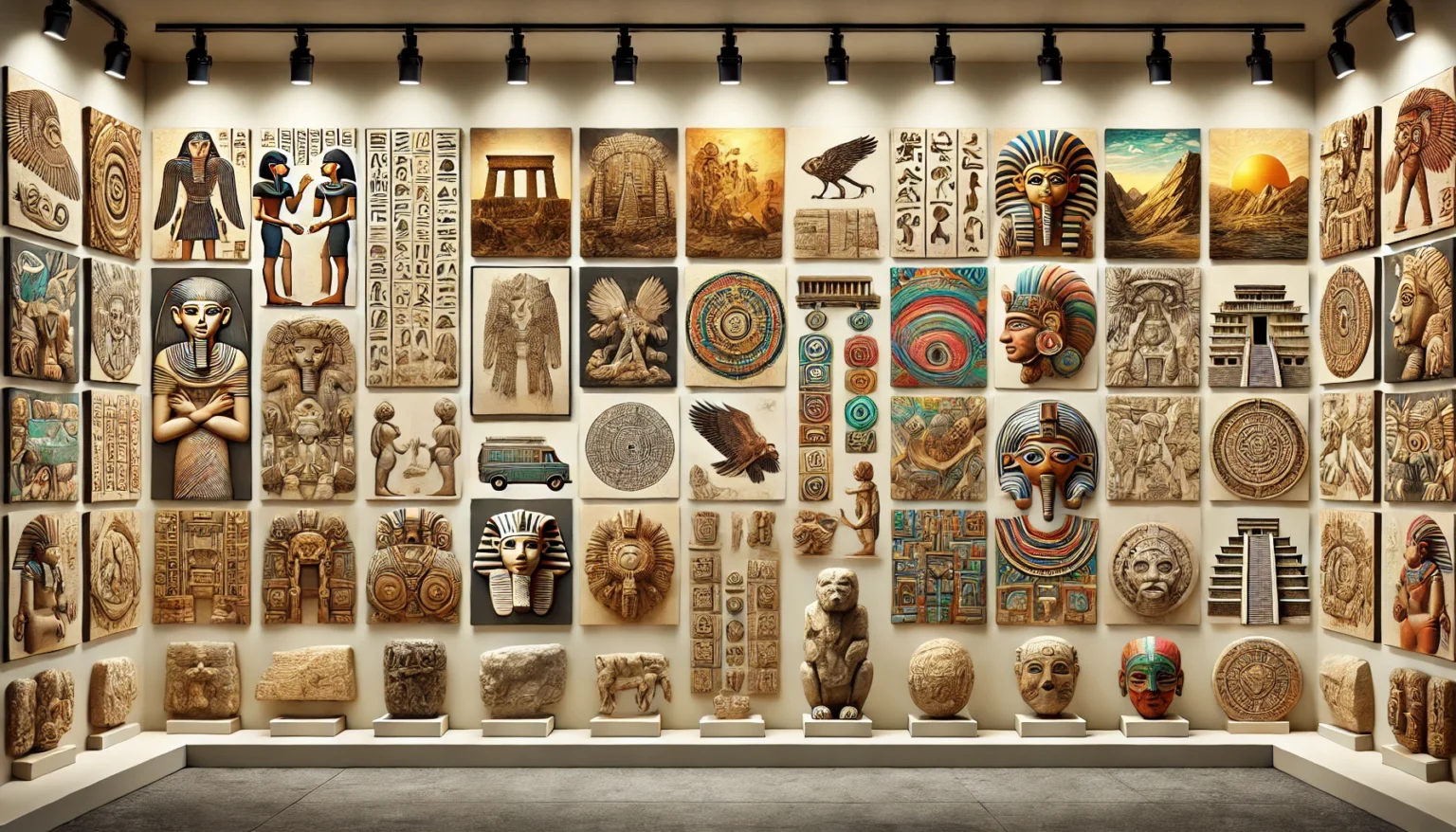Ancient artz represents the enduring artistic legacy of human civilizations, showcasing how creativity evolved from primitive cave drawings to architectural masterpieces. This article explores the origins, styles, and significance of ancient art, highlighting its influence on modern creativity and culture.
The Roots of Ancient Artz :
- Ancient art dates back over 40,000 years to the Paleolithic era.
- Early humans used charcoal, ochre, and natural pigments to create cave paintings, such as those in the Chauvet-Pont-d’Arc Cave in France.
- These early artworks, depicting animals, symbols, and daily life, were likely used for spiritual rituals, communication, or storytelling.
🔹 Key Takeaways:
- Ancient artz began as a form of expression, storytelling, and spirituality.
- Early examples include cave paintings, figurines, and carvings.
- Art played a vital role in human connection with nature, beliefs, and society.
Major Regions and Styles of Ancient Artz :
1. Egyptian Art (3000 BCE – 30 BCE)
- Egyptian art is famous for its monumental structures, hieroglyphics, and tomb paintings.
- Iconic works include the Pyramids of Giza, the Great Sphinx, and statues of pharaohs.
- Art reflected religious beliefs, the afterlife, and divine kingship.
🔹 Key Features:
- Highly symbolic and formal art style.
- Depictions of gods, pharaohs, and daily life.
- Hieroglyphics blended art with language.
2. Mesopotamian Art (3100 BCE – 539 BCE)
- Mesopotamia, known as the cradle of civilization, produced art centered on religion, mythology, and power.
- Structures like ziggurats and art pieces like the Stele of Hammurabi conveyed authority.
🔹 Key Features:
- Focus on royalty, warfare, and divine beings.
- Ziggurats were grand temple structures symbolizing power.
- Cylinder seals were used for storytelling and documentation.
3. Greek Art (800 BCE – 31 BCE)
- Greek art emphasized ideal human forms, balance, and naturalism.
- Masterpieces include the Parthenon, Venus de Milo, and Discobolus.
🔹 Key Features:
- Sculptures focused on idealized beauty and movement.
- Common themes included gods, mythology, and heroism.
- Mastery in pottery, sculpture, and architecture.
4. Roman Art (509 BCE – 476 CE)
- Romans built upon Greek traditions but emphasized realism, functionality, and grandeur.
- Notable works include the Colosseum, Pantheon, and realistic portrait sculptures.
🔹 Key Features:
- Highly detailed and lifelike sculptures.
- Grand public architecture like amphitheaters and aqueducts.
- Extensive use of mosaics and frescoes.
5. Indian Art (2500 BCE – Present)
- Indian art is deeply spiritual and mythological, influenced by Hinduism, Buddhism, and Jainism.
- From Indus Valley figurines to intricate temple carvings, Indian art showcases diverse traditions.
🔹 Key Features:
- Use of rich colors, intricate patterns, and religious iconography.
- Depictions of deities, epics, and cosmic symbolism.
- Influences seen in temple carvings, murals, and sculptures.
6. Chinese Art (2000 BCE – Present)
- Chinese art reflects nature, harmony, and philosophy.
- Calligraphy, jade carvings, and ceramics remain fundamental.
🔹 Key Features:
- Emphasis on balance, minimalism, and fluidity.
- Natural materials like jade, silk, and porcelain.
- Influenced by Confucianism, Daoism, and Buddhism.
7. Mesoamerican Art (1200 BCE – 1500 CE)
- Civilizations like the Maya, Aztec, and Olmec created art tied to rituals, astronomy, and mythology.
- Iconic pieces include the Mayan stelae and Aztec Sun Stone.
🔹 Key Features:
- Art centered on rituals, gods, and cosmic cycles.
- Intricate carvings and vibrant murals.
- Use of jade, obsidian, and gold in ceremonial objects.
Mediums of Ancient Artz :
- Stone & Marble – Used for sculptures, monuments, and temples (e.g., Egyptian pyramids, Greek statues).
- Clay & Pottery – Functional and decorative items (e.g., Greek amphorae, Roman mosaics).
- Natural Paints – Cave paintings, tomb frescoes, and murals (e.g., Lascaux Cave, Egyptian tomb art).
- Wood & Jade – Wood carvings and jade sculptures were highly valued in Asia.
- Metalwork – Bronze, gold, and silver used in jewelry, statues, and weapons.
The Influence of Ancient Artz on Modern Creativity :

Ancient art continues to inspire contemporary artists, architects, and designers.
🔹 Modern Influences:
- Architecture: Neoclassical buildings feature Greek and Roman columns, domes, and symmetry (e.g., U.S. Capitol).
- Fine Arts: Ancient calligraphy and ink painting influence modern minimalist and abstract art.
- Fashion & Design: Egyptian motifs and patterns appear in modern jewelry and textiles.
- Sculpture & Street Art: The expressive power of prehistoric cave paintings can be seen in abstract and graffiti art.
Significance of Ancient Artz :
- Represents cultural, religious, and historical values.
- Provides insight into early human societies and beliefs.
- Continues to shape modern art, architecture, and storytelling.
Resources for Exploring Ancient Artz :
For those interested in exploring ancient art, check out these valuable resources:
- National Gallery of Art – Features collections of Greek, Roman, and Byzantine art.
- Ancient History Encyclopedia – Offers detailed articles on ancient civilizations and their art forms.
The Timeless Legacy of Ancient Art :
Ancient artz is a testament to humanity’s enduring creativity and ingenuity. From the earliest cave paintings to grand temples and sculptures, art has been a constant companion throughout history.
By studying ancient art, we gain a deeper appreciation for the artistic journey of human civilization and its lasting influence on modern creativity.
💡 The beauty of ancient art lies not just in its past, but in its ongoing inspiration for the future.


